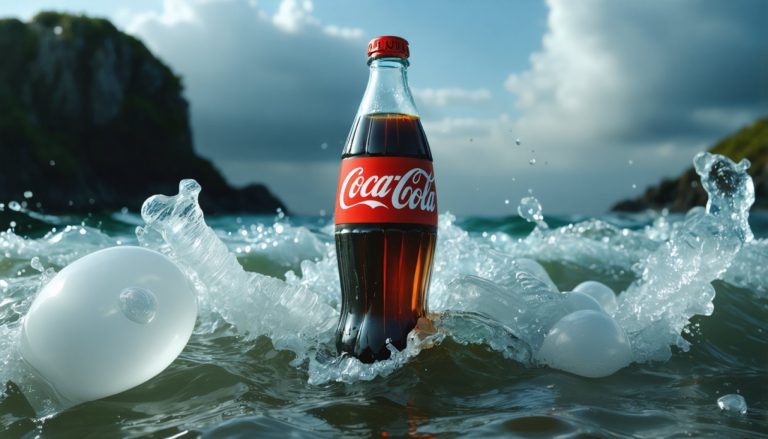
- Coca-Cola is expected to generate more than 4.1 million metric tons of plastic waste annually by 2030, highlighting the urgent need for improved environmental strategies.
- The company's current efforts include promises for 100% recycled packaging and increased use of recycled materials, although progress remains slow.
- Innovative alternatives, such as biodegradable plastics and plant-based packaging, are emerging as viable solutions for sustainable packaging.
- Consumer behavior plays a key role in driving change by choosing recycled options and supporting sustainable brands.
- The situation requires a collective approach that combines corporate responsibility and consumer choice to achieve a more sustainable future.
Under the relentless march of time, Coca-Cola's reliance on plastic is becoming increasingly evident. The company is projected to exceed a staggering 4.1 million metric tons of plastic waste annually by 2030, casting a huge shadow over the ecological future of our planet. This projection is a clear call for change, resonating across industries and challenging one of the most iconic brands in history to rethink its environmental strategies.
Brightly labeled bottles glowing under the fluorescent lights of stores are invisible giants contributing to the rising tide of plastic waste overwhelming oceans and clogging delicate ecosystems. The sheer volume, measured against well-known landmarks, could easily overshadow the height of Mount Everest in less time than it takes for a single plastic bottle to decompose — a troubling contrast to natural sustainability.
Coca-Cola, a titan in the beverage industry, finds itself at a critical juncture. With over 1.9 billion servings of its beverages consumed daily in 200 countries, every plastic bottle carries the weight of sustainability. The company's promises to address this crisis have been publicly documented: transitioning to 100% recycled packaging and increasing the use of recycled materials. However, progress remains exceedingly slow.
Amid the noise for eco-friendly packaging, alternatives such as biodegradable plastics, recycled materials, and innovative reuse programs are emerging as beacons of hope. Companies experimenting with plant-based packaging and compostable forms of packaging are beginning to attract consumer interest, indicating a path that Coca-Cola must explore to maintain its market dominance and ethical stewardship.
At the heart of this environmental battle lies a powerful message: collective responsibility. Consumers, empowered by awareness and choice, play a crucial role in driving change. Through a simple yet powerful act — choosing recycled options, supporting brands that prioritize sustainability, and reducing personal plastic use — individuals can influence global giants.
As Coca-Cola and consumers stand at this pivotal point of choice and consequence, the future demands not just a change in method but also a shift in mindset. This is a mission that requires a tapestry of innovation, collaboration, and unwavering commitment. For as the Earth spins and the years roll on, every decision echoes with the potential for a greener future, a world where corporate responsibility seamlessly intertwines with the rhythm of nature.
Plastic Tsunami: Unveiling Coca-Cola's Environmental Impact and the Path Forward
Coca-Cola's Plastic Problem: A Deeper Insight
Coca-Cola's annual plastic use is expected to exceed 4.1 million metric tons by 2030. This staggering figure illuminates a critical environmental challenge for one of the most iconic brands in the world, underscoring the urgent need for innovative and sustainable solutions. Let’s explore additional facets of this issue and investigate viable approaches to address this ecological dilemma.
Beyond the Surface: Environmental Impact and Sustainability
1. Recycling Challenges:
– Despite promises for 100% recycled packaging, logistical and systemic barriers hinder progress. Many regions lack the infrastructure for effective recycling, leading to increased landfill waste.
– Consumers and organizations must advocate for improved recycling systems and support legislation that encourages change.
2. New Packaging Trends:
– Biodegradable Plastics: Not all biodegradable materials are equal in terms of decomposition speed. Companies must ensure that these alternative materials genuinely reduce environmental impact.
– Plant-Based Packaging: Brands like Coca-Cola are exploring plant-based bottles, which could significantly reduce carbon emissions if adopted on a larger scale.
3. Industry Innovations:
– Collaborations like Loop and Terracycle focus on reusable packaging systems, presenting promising scalable models for a circular economy.
4. The Role of Market and Consumers:
– Consumer preferences are shifting towards sustainability, driving market trends. Brands aligning with ecological initiatives often enjoy greater loyalty and sales.
How-to Steps and Life Hacks for Reducing Plastic Use
1. Choose Alternatives:
– Opt for brands that offer bottles or aluminum packaging instead of plastic.
2. Support Local Recycling Programs:
– Participate in community clean-up efforts and encourage businesses to implement more comprehensive recycling options.
3. Educate and Advocate:
– Raise awareness on social media about the impact of plastic waste and advocate for corporate responsibility and government support for sustainable practices.
Real-World Examples and Industry Trends
– Companies like Unilever have adopted alternatives to plastic, aiming to significantly reduce new plastic by using refillable containers and filling stations.
– The beauty industry (e.g., Lush, The Body Shop) is pioneering compostable and reusable packaging, setting a precedent for beverage companies.
Controversies and Limitations
– Risks of "Greenwashing":
– Some companies may exaggerate their eco-friendly initiatives, misleading consumers. It’s crucial to research and support brands with credible sustainability metrics.
– Economic Constraints:
– Transitioning to sustainable packaging can be financially burdensome for smaller companies without significant investments.
Feasible Recommendations
1. For Consumers:
– Reduce single-use plastic consumption and choose products with sustainable packaging.
2. For Coca-Cola and Similar Companies:
– Invest in research and development for innovative scalable solutions for sustainable packaging and collaborate with NGOs to promote community-level change.
3. For Policymakers:
– Develop and implement stringent regulations on plastic use that encourage investment in recycling infrastructure and sustainable practices.
Final Thoughts
By harnessing the collective power of policy, innovation, and consumer choice, we can mitigate Coca-Cola's projected plastic waste and move towards a more sustainable future. For more information on sustainable practices and community initiatives, explore the work of groups like Greenpeace.



